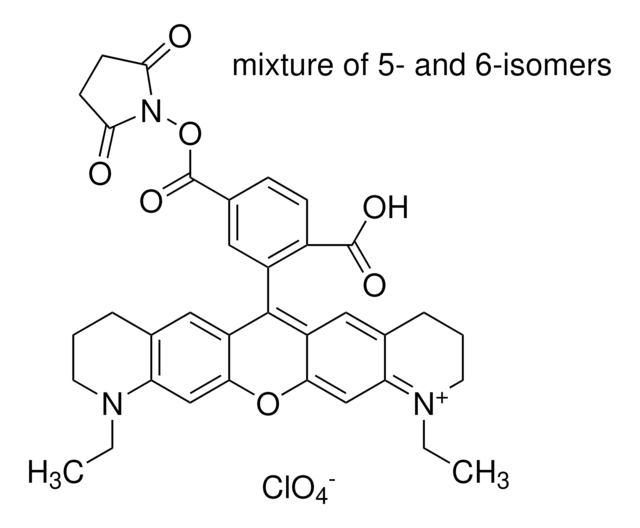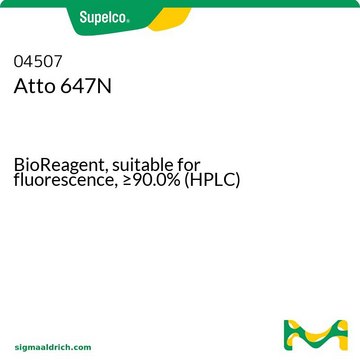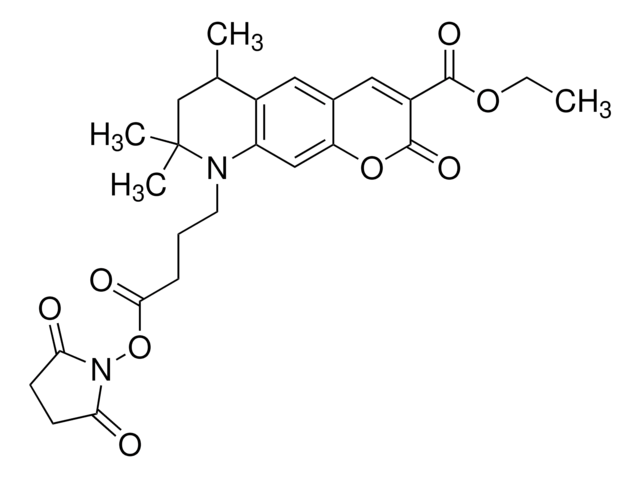59746
Atto Rho14
BioReagent, suitable for fluorescence
Sign Into View Organizational & Contract Pricing
All Photos(1)
About This Item
UNSPSC Code:
12352200
NACRES:
NA.32
Recommended Products
product line
BioReagent
form
solid
manufacturer/tradename
ATTO-TEC GmbH
fluorescence
λex 625 nm; λem 646 nm
suitability
suitable for fluorescence
storage temp.
−20°C
General description
Atto Rho14 is a new bright rhodamine featuring a functionality for coupling to biomolecules such as DNA, RNA or proteins. The label shows strong absorption, and extraordinarily high fluorescence quantum yield. In addition the dye exhibits an exceptionally high photostability. After coupling to a substrate Atto Rho14 carries a net electrical charge of +1.
Absorption and fluorescence are pH-independent in the range of pH 2 to 11, used in typical applications. The dye is moderately hydrophilic.
Absorption and fluorescence are pH-independent in the range of pH 2 to 11, used in typical applications. The dye is moderately hydrophilic.
Application
Atto Rho14 is a new bright rhodamine featuring a functionality for coupling to biomolecules such as DNA, RNA or proteins. The label shows strong absorption, and extraordinarily high fluorescence quantum yield. In addition the dye exhibits an exceptionally high photostability. After coupling to a substrate Atto Rho14 carries a net electrical charge of +1.
Absorption and fluorescence are pH-independent in the range of pH 2 to 11, used in typical applications. The dye is moderately hydrophilic.
Absorption and fluorescence are pH-independent in the range of pH 2 to 11, used in typical applications. The dye is moderately hydrophilic.
Legal Information
This product is for Research use only. In case of intended commercialization, please contact the IP-holder (ATTO-TEC GmbH, Germany) for licensing.
Storage Class Code
13 - Non Combustible Solids
WGK
WGK 3
Flash Point(F)
Not applicable
Flash Point(C)
Not applicable
Choose from one of the most recent versions:
Certificates of Analysis (COA)
Lot/Batch Number
Don't see the Right Version?
If you require a particular version, you can look up a specific certificate by the Lot or Batch number.
Already Own This Product?
Find documentation for the products that you have recently purchased in the Document Library.
Ha Na Kim et al.
Chemical Society reviews, 37(8), 1465-1472 (2008-07-24)
This tutorial review focuses on the recent development of rhodamine derivatives, in which the spirolactam (non-fluorescent) to ring-opened amide (fluorescent) process was utilized.
Johann Grognux et al.
Molecular bioSystems, 2(10), 492-498 (2007-01-12)
A lipase substrate microarray was obtained by printing aliphatic C2-C12 monoesters of (5R)- and (5S)-3-(5,6-dihydroxyhexyloxy)benzaldehyde by reductive alkylation on amine-functionalized glass slides coated with bovine serum albumin and a short PEG linker. The microarray features 12 substrates and their 66
Pingwu Du et al.
Inorganic chemistry, 49(23), 10753-10755 (2010-10-30)
We describe ZRL1, a turn-on colorimetric and red fluorescent zinc ion sensor. The Zn(2+)-promoted ring opening of the rhodamine spirolactam ring in ZRL1 evokes a 220-fold fluorescence turn-on response. In aqueous media, ZRL1 turn-on luminescence is highly selective for Zn(2+)
Yu Kushida et al.
Bioorganic & medicinal chemistry letters, 22(12), 3908-3911 (2012-05-23)
We have developed a novel red fluorescent dye, 2Me SiR600 (λ(em)=613 nm), in which the O atom of Rhodamine Green at the 10 position of the xanthene moiety is replaced with a Si atom, as a scaffold for probes to
Articles
Fluorescence lifetime measurement is advantageous over intensity-based measurements. Applications include fluorescence lifetime assays, sensing and FLI.
Our team of scientists has experience in all areas of research including Life Science, Material Science, Chemical Synthesis, Chromatography, Analytical and many others.
Contact Technical Service




